Sloped front yard landscaping ideas can turn a problem into a possibility. Slopes often cause erosion, mowing hassles, and awkward access. But they also offer potential. A slope can become a multi-level garden, a stone feature, or a bold curb appeal upgrade.
This guide shares practical and trending solutions. You’ll see how to stabilize slopes with retaining walls, create low-maintenance landscaping, and design small sloped front yard landscaping ideas that save space while keeping style.
Table of Contents
Quick Yard Assessment: Slope, Soil & Drainage Basics
Before jumping into design, take time to evaluate your slope.
- Slope Type: A gentle slope may only need groundcovers and small rock edging, while steep slopes usually require terracing or retaining walls.
- Soil Type: Clay-heavy soils struggle with drainage, while sandy soils may erode faster.
- Water Flow: Watch where rainwater collects. Poor drainage can ruin even the best design.
- Access Needs: Ask yourself: can you walk comfortably up and down? Do you need steps or paths?
👉 For small sloped front yard landscaping ideas, the assessment is crucial. Compact slopes often require creative solutions—like small boulders or tiered planting beds—that balance practicality with beauty.
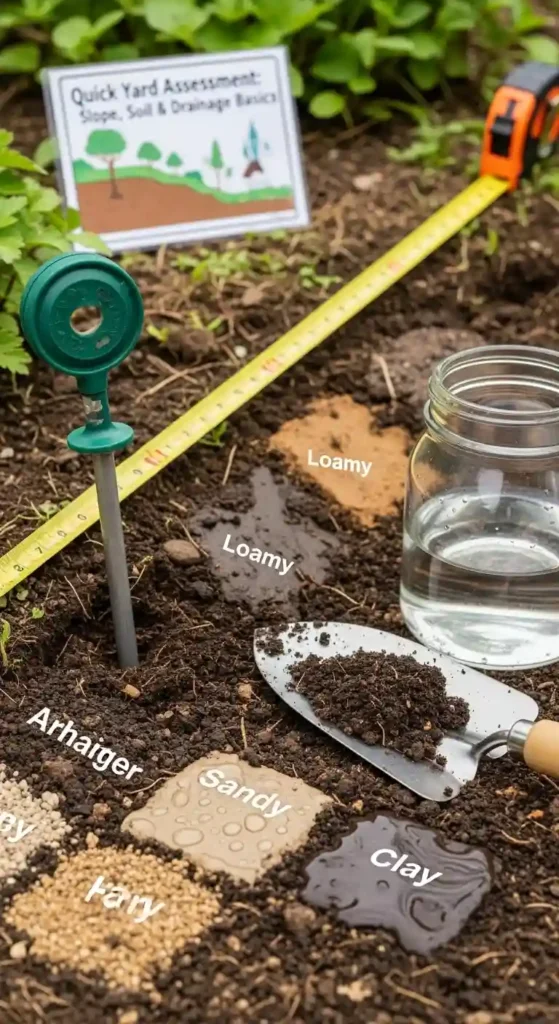
Low Maintenance Sloped Front Yard Landscaping
One of the top trends in 2025 is cutting back on lawn care and choosing low-maintenance sloped front yard landscaping. Mowing and watering a slope is exhausting, so homeowners are turning to alternatives.
Practical Low-Maintenance Approaches
- Groundcovers instead of grass: Creeping thyme, sedum, or juniper naturally stabilize soil.
- Mulch and rock bands: Retain moisture, suppress weeds, and reduce erosion.
- Native plantings: Drought-tolerant species thrive with little care and support pollinators.
- No-lawn naturalistic slopes: A popular choice from the “No Lawns” movement—mulch the slope heavily, add woody debris or boulders, and let native shrubs and grasses establish.
👉 Pairing these methods with a few boulders or gravel paths can give you a polished, modern look that saves you hours of upkeep each month.
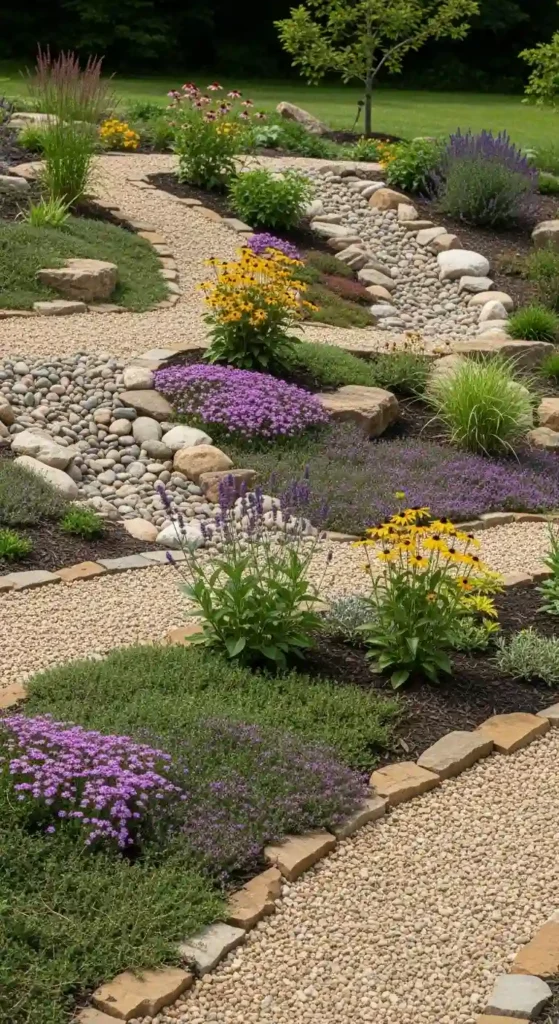
Stabilize First: Retaining Walls, Terracing & Modern Systems
Stability is the foundation of every good slope design. Here are the most effective methods:
Retaining Walls
- Stone: Classic, durable, and timeless.
- Timber: Affordable but shorter lifespan.
- Concrete blocks: Modular, quick to install, and strong.
- Gabions: Steel baskets filled with rocks—modern, permeable, and effective for drainage.
Pro Tip: Any wall over 3–4 feet may need professional engineering and local permits. Always include drainage (weep holes, gravel backfill) to prevent collapse.
Terracing
Breaking a slope into tiered levels creates usable flat areas for gardens, seating, or pathways. Terraces can double as raised beds, making planting easier.
Geocells & Geogrids (Overlooked but Powerful)
A newer option involves honeycomb-like grid systems (geocells) filled with soil, gravel, or plants. They stabilize steep slopes and allow for a natural, vegetated look—perfect if you want an eco-friendly alternative to hard walls.
👉 For small sloped front yard landscaping ideas, even a single short retaining wall or a two-tier terrace can make a huge difference in usability and appearance.
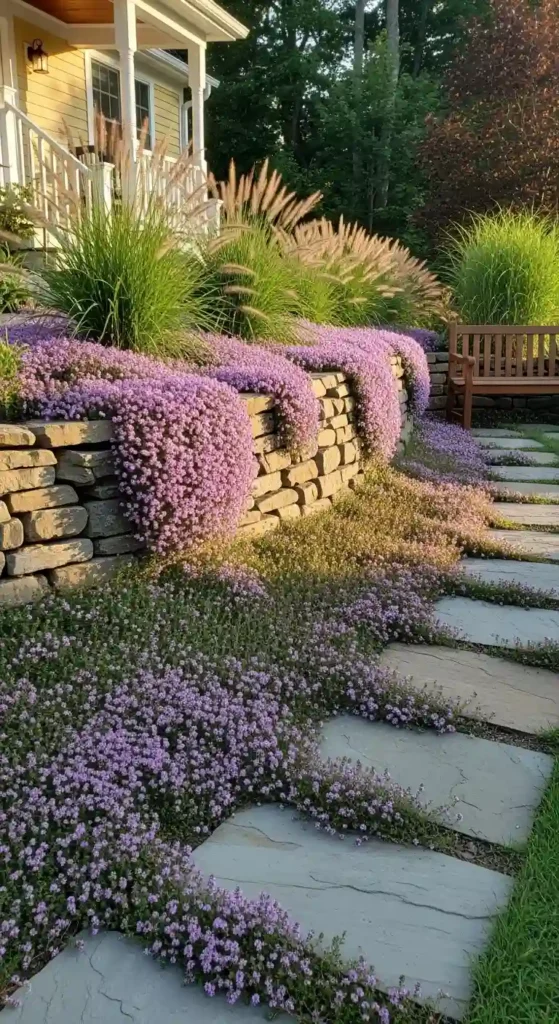
Drainage & Erosion Control Solutions
Water is your slope’s biggest enemy. Without proper management, soil washes away and plants struggle.
Popular Drainage Fixes
- Dry Creek Beds: A shallow, rock-lined channel that directs water naturally. Doubles as a landscape feature.
- French Drains: A buried pipe system with gravel, ideal for redirecting subsurface water.
- Rain Gardens: Plant-filled basins that capture runoff and allow it to slowly filter back into the soil.
Mistakes to Avoid
- Forgetting weep holes in retaining walls.
- Using the wrong backfill behind walls.
- Installing drains without an outlet.
👉 Even in small sloped front yards, adding a miniature dry creek or rock swale can make a slope both functional and eye-catching.
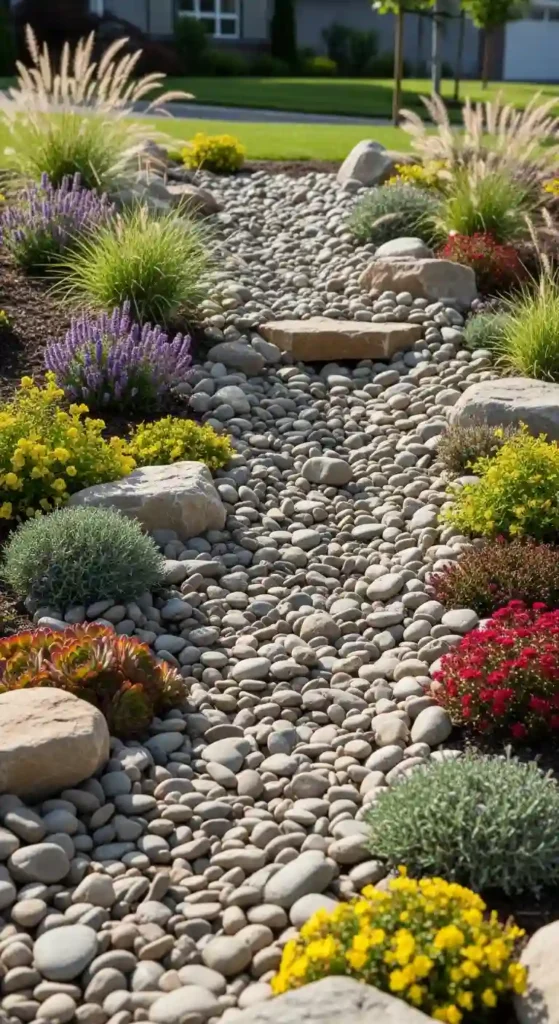
Steps, Paths & Lighting: Making Slopes Walkable
A front yard should be safe and inviting—not an obstacle course. Adding functional steps and lighting transforms usability.
- Stone or paver steps: Natural-looking and durable.
- Switchback paths: Zig-zag walkways reduce steepness.
- Landings: Rest areas add safety and design interest.
- Lighting: Low-voltage LED or solar step lights improve visibility and curb appeal.
👉 Combine steps with plants tucked along the edges to soften hard lines and create flow.
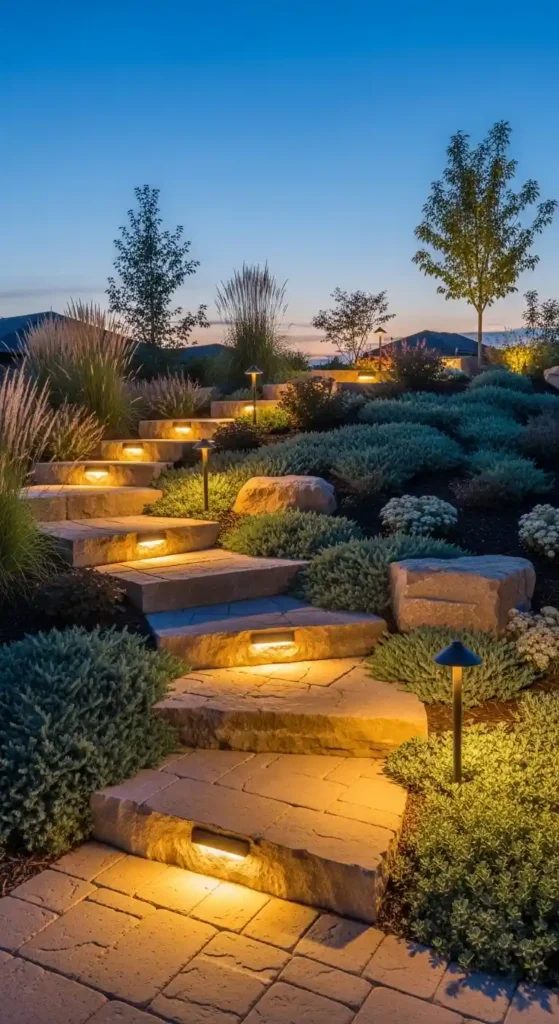
Planting Palettes That Hold the Hill
Plants are your slope’s best friends—they prevent erosion, add texture, and bring color.
Groundcovers & Shrubs
- Sunny Slopes: Creeping thyme, ornamental grasses, lavender.
- Shady Slopes: Hostas, ferns, creeping phlox.
- Erosion Control: Juniper, cotoneaster, or daylilies.
Regionalized Planting
Adapt choices to your climate:
- Drought-prone: Succulents, cactus, native grasses.
- Cold climates: Shrubs like juniper or alpine groundcovers.
- Wildfire-prone: Firewise plants like yarrow or ceanothus.
👉 For small sloped front yard landscaping ideas, choose compact shrubs and perennials that won’t outgrow the space but still anchor the soil effectively.
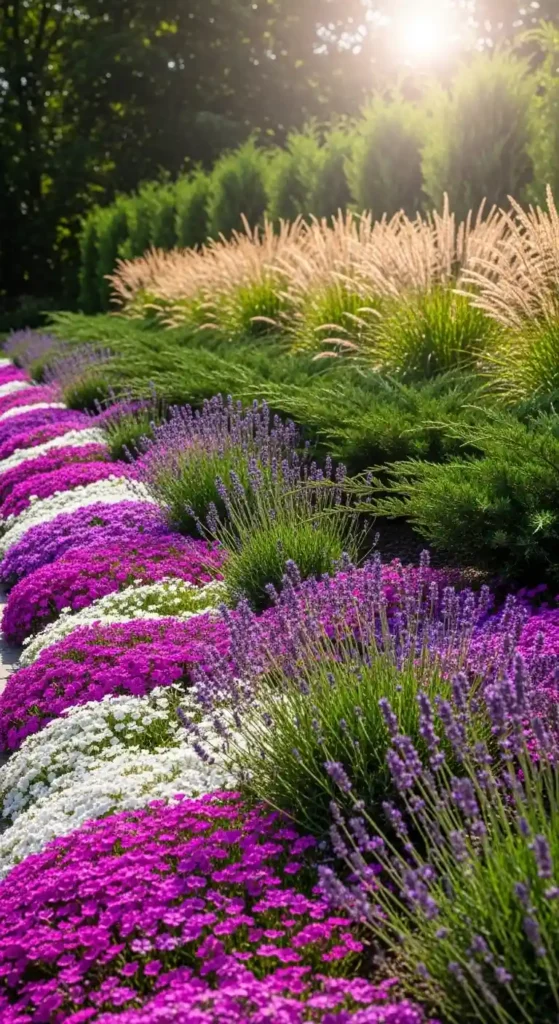
Style Lookbooks for Inspiration
Slopes lend themselves to distinctive design styles. Here’s how to apply them:
- Modern: Clean terraced walls, LED-lit steps, gravel bands, and structured plant palettes.
- Cottage: Curved stone steps, overflowing perennials, and rustic wood accents.
- Xeriscape: Gravel mulch, drought-tolerant natives, and sculptural boulders.
- Woodland: Shady understory plants, mossy rocks, and natural pathways.
👉 Whether you’re planning big changes or simply want small sloped front yard landscaping ideas, these styles can be scaled to fit your space.
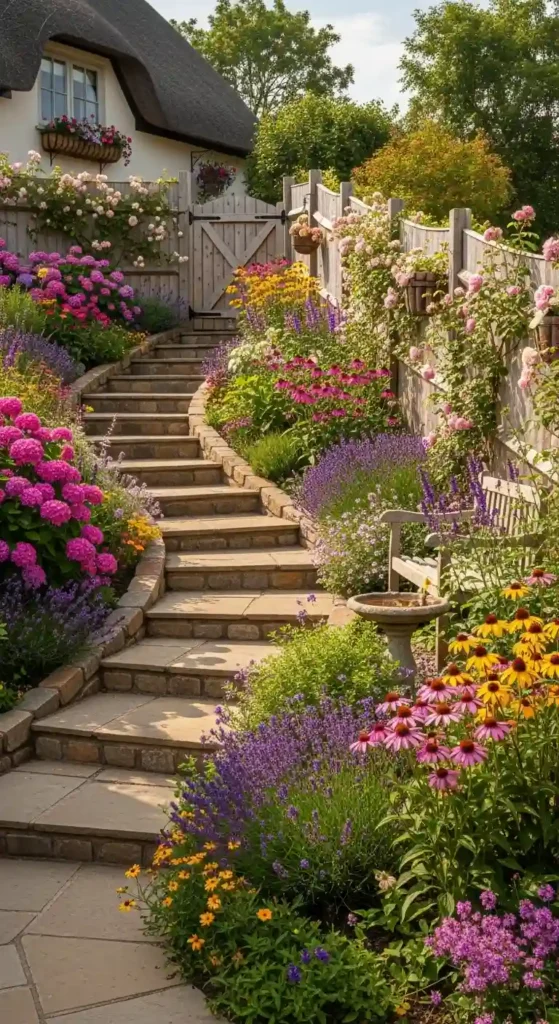
Budget Planner: DIY vs Pro
Slope projects can vary widely in cost.
- DIY Budget-Friendly: Mulch, groundcovers, small rocks (few hundred dollars).
- Hybrid Approach: DIY planting + professional help for walls or drainage (mid-thousands).
- Full Professional Design: Engineered retaining walls, irrigation, and lighting (can reach tens of thousands).
👉 Even low maintenance sloped front yard landscaping can be achieved affordably if you focus on erosion-control plants and simple hardscape features.
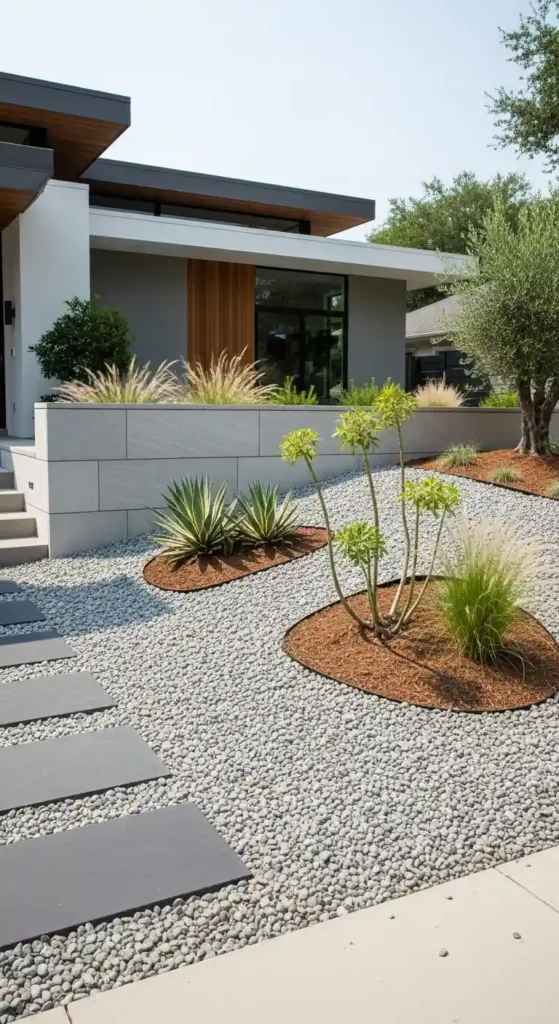
Maintenance Calendar & Mistakes to Avoid
Even the best designs need upkeep.
- Spring: Check drains/weep holes, top up mulch, replace any lost plants.
- Summer: Monitor watering, especially on sunny slopes.
- Fall: Remove debris, prep drainage for heavy rains, test lighting.
- Winter: In cold regions, protect tender plants and check freeze-prone walls.
Mistakes homeowners make:
- Planting turf grass (hard to mow, water-intensive).
- Over-hardscaping without drainage.
- Ignoring safety (steep, unlit slopes).

Conclusion
Designing a slope isn’t just about controlling erosion—it’s about turning a challenge into an opportunity.
With these sloped front yard landscaping ideas, you can stabilize your yard, simplify maintenance, and add serious curb appeal.
Whether you’re creating a modern terraced design, going for low-maintenance landscaping, or looking for small sloped front yard landscaping ideas, the right approach can make your slope the star of your home’s exterior.
FAQ’s
What is the cheapest way to landscape a slope?
Mulch + groundcovers + boulders is the most affordable option.
What plants work best on slopes?
Juniper, creeping thyme, ornamental grasses, and native perennials are strong erosion-fighters.
How do I design a small sloped front yard?
Use compact terraces, groundcovers, and strategic boulders—avoid overcrowding.
Can slope landscaping be low-maintenance?
Yes. Replace turf with groundcovers, add mulch, and integrate native or drought-tolerant species.
